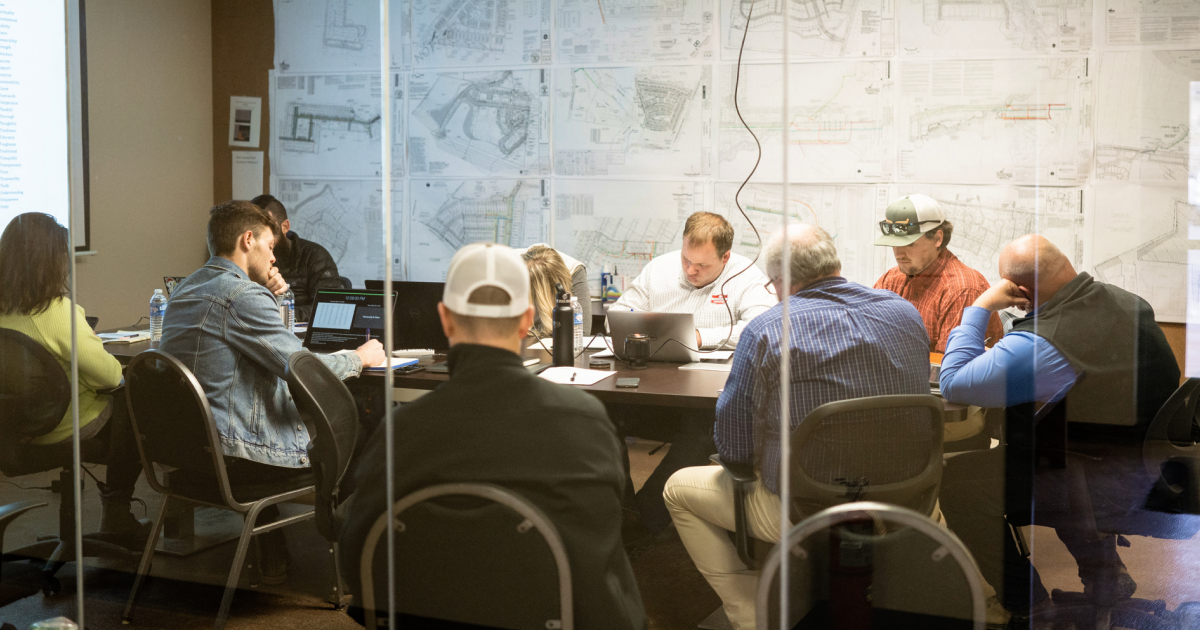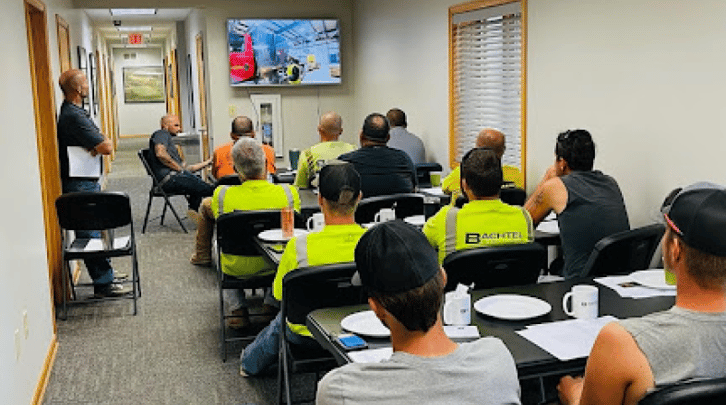Onboarding Your Small or Medium Business With BuildWitt Training
Written by Megan Hamilton
September 28, 2022

When you’re running a small to medium sized business, training software is a big investment. You want to get your money’s worth and make it worth your team’s time.
We’ll walk you through the most important practices for onboarding small and medium businesses with BuildWitt Training. Plus, we’ll share stories from real customers (not actors) who use the software to help you decide how to best onboard your team.
Let’s get started.
How do I onboard my small or medium business with BuildWitt Training?
Onboarding with BuildWitt Training starts with a kick-off call, when you’ll get to tell us more about your needs and start making initial decisions about the roll-out. Within two weeks, we’ll have a second meeting to further strategize how to best onboard your business.
During those meetings and the roll-out itself, we’ll help you navigate the following steps.
Choose one person to be the point of accountability
You’ll pick your point of accountability during your onboarding call. This person in your company will own the BuildWitt Training roll-out and be accountable if it fails. That’s a big responsibility, so you need someone you trust to handle it.
They should be open to trying new things and willing to make time to take the courses themselves. In other words, they will lead by example and help the rest of your team through the change.
Identify internal champions
You'll also need internal champions who will lead the charge to adopt BuildWitt Training and put it into practice in the field. To find your internal champions ask yourself:
- Who on the team is hungry to learn?
- Who’s seeking opportunities to grow?
- Who’s excited to adopt new stuff?
- Who really wants to work their way up to become a leader?
List those people, and during your onboarding call, we’ll talk about how you can engage them in the roll-out process.
Pick initial learning plan(s)
BuildWitt Training comes with hundreds of video lessons, plus you can add your own courses. However, assigning all that to your crew at once would lead to chaos and set them up to fail.
Instead, we’ll help you choose one or two learning plans to overcome the biggest challenges your business is facing right now.
Ask yourself, “What are the hottest fires burning in my company?” Maybe you need clear, consistent onboarding for new hires. Maybe your crews and leaders struggle to communicate. Maybe you need to get new hires up to speed fast.
We’ll talk about those big needs and which courses will be most helpful during your onboarding call. In the meantime, you can get ideas from our course catalog to see what might be most beneficial.
Decide who will use BuildWitt Training first
In a small company, you may decide your whole team will train together. That’s great! But before they begin, introduce BuildWitt Training to a select, core group of team members who need to be onboarded before you roll the program out to everyone.
Your core group should include your point of accountability, internal champions, foremen, and field supervisors.
Getting foremen and field supervisors involved is critical to your success. You need the people who have their boots on the ground to learn this stuff so they can help introduce it to their crews.
Now, they may be skeptical or unenthusiastic about using BuildWitt Training at first. That’s normal. Maybe other training programs haven’t worked, or maybe they’ve gotten by “just fine” without a training program before. Either way, your field leaders have gotten a big dose of skepticism over the years. Some people—especially “old dogs” who have worked in the Dirt World for decades—may also resist change just because it’s new. That’s normal, too.
It can be tempting to leave foremen and field supervisors out of the onboarding process for those reasons. Don’t do that! Don’t discount your field leaders. Today’s skeptics are tomorrow’s biggest fans.
“When they see something that works for them in the field, they will use it and be the best champions and supporters,” says Jay Collup, Director of Field Development at BuildWitt.
That’s huge for driving success. When the foreman uses BuildWitt Training and sees the benefits, he will make sure his crew uses it. Soon, the whole team benefits—and next thing you know, the company and clients reap the rewards.
That’s why you need strong buy-in from your field leaders. They will help you lead the charge to adopt BuildWitt Training at your company. That said, if you have more than 40 employees, it may be time to add a dedicated safety and training role to your team. They’ll take some of the responsibility off the field leaders and help ensure the team’s training success.
Choose when and where to start
When introducing BuildWitt Training, choose a time and place where you and your crew can consistently meet to go over the coursework. These questions can help you find the right time and place:
- How often should we meet?
- When do people already meet for JSAs, safety stand downs, toolbox talks, classroom training, etc.?
- How can we fit BuildWitt Training into our existing work schedules?
- Do we want people to train together or individually?
Once you decide the details, start that introductory meeting by telling your team why you invested in training. Cast a vision for where the company’s going and how BuildWitt Training will help them on the jobsite, so people can get excited about onboarding. (Or at the very least, the people who dislike change can become willing to give it a try.)
During your onboarding call, we’ll help you decide when and where to introduce BuildWitt Training to your team and talk about ways to get them amped up about it.
Pick a day and time to review the dashboard
Congrats—you’re ready to start the onboarding process with your team members!
Right before you introduce them to BuildWitt Training, pick a specific day and time to review the dashboard. When you review the dashboard, you’ll see who’s completed what, what’s going well, and where your team needs extra help or improvement.
Then, in that first onboarding meeting, let your team know exactly when you will review the dashboard. This holds you accountable to review the dashboard and stay aware of how the training is going. It also holds them accountable to do the lessons, because they know you’ll check up on them.
Some companies give crew members incentives to encourage them to complete the training. You may consider rewarding the person who was most consistent or offering chances to win prizes for completing lessons.
Multiply your trainers
You’re now officially up and running with BuildWitt Training. Your team has been using it for a little while, and you’re getting into a routine. Now, have your BuildWitt Training administrator teach someone else to handle those tasks.
You might be thinking, Wait, what? They just learned how to do the admin themselves.
That’s true, but you need multiple people who can handle the administration that goes along with a training management system. That way, one person won’t be a bottleneck. If they need to go on vacation or handle other parts of the business, the second admin can jump in and take care of things.
Having your admin train a second person also helps ensure the admin truly understands how to use the system—they have to understand it to be able to explain it to someone else. Plus, having two admins drives team collaboration. They’ll work closely and help each other, giving the rest of the team better support.
Leverage your BuildWitt Success Team
Once you’re up and running with BuildWitt Training, we won’t just leave you hanging. You’ll have the BuildWitt Success Team by your side to help:
- Set training and team development goals
- Determine what success looks like for your team
- Continue to integrate BuildWitt Training into your company
- Tailor your training experience to help you reach your goals
- And more!
Basically, the BuildWitt Success Team is there to support you and help integrate the training software smoothly. They have a lot of expertise and love to help people, so don’t hesitate to reach out with any questions, concerns, or feedback you have.
How are other companies rolling BuildWitt Training out to their teams?
Seeing how others do things is one of the best ways to learn. Here’s how our customers are introducing BuildWitt Training to their teams—and how you can apply these strategies at your company.
Bachtel Excavating
Bachtel Excavating is a small company that hires people based on willingness to learn and attitude—not past excavation experience. As such, half their field crew is under age 26, and many are new to the Dirt World.
Bachtel needs to get these young rookies up to speed faster . . . but to do that, they first hit the brakes. Bachtel’s leadership took everyone off the jobsite and into the classroom to give them proper training on leadership, safety, and work procedures.
“Sometimes, you have to slow down to go fast,” Bachtel leaders explain. “Pulling the entire team out of the field, in the heart of our busy season, is not easy. However, it is necessary.”
Bachtel worked BuildWitt Training into their regular half-day, all-hands meetings. The company sometimes provides meals in the classroom during the training. After each video lesson, leaders facilitate discussions about the topic and how it applies to their team.
Key takeaways from Bachtel:
- Slow down so your crew can get onboard.
- Make BuildWitt Training part of regular, pre-existing meetings.
- Give leaders the responsibility of helping the crew through the training.
- Adding a meal to the mix never hurts!
 Bachtel crew members using BuildWitt Training at a Friday all-hands meeting
Bachtel crew members using BuildWitt Training at a Friday all-hands meeting
Lyness Construction
Operations manager Corey took ownership of implementing BuildWitt Training at Lyness Construction. He helped start weekly, group training sessions with foremen and crews, as well as monthly sessions with project managers and other leaders.
Having regular training sessions for the first time was a big deal; previously, Lyness’ training expert pulled the team together when it was convenient. (As you can guess, it was rarely ever convenient.)
Corey and the rest of the Lyness team also set very clear goals for what they want to do with BuildWitt Training:
- Give employees world-class training that better qualifies them for advancement.
- Help employees understand how fulfilling and purposeful their work is.
- Use habits and skills from the training to uphold quality standards.
- Improve employee retention and new-hire onboarding.
- Give managers their time back.
- Create camaraderie.
The team told us, “We firmly believe aiming for and accomplishing all of these objectives will contribute positively toward our company culture and overall company and individual growth.”
Key takeaways from Lyness:
- Train consistently and often.
- Set clear, specific goals.
- Think about how you can use BuildWitt Training to help your company long-term.
Will Power Excavation
As the owner of a small business, Will Schuler has always trained the team at Will Power Excavation himself using in-person, classroom instruction.
When he adopted BuildWitt Training, he set one goal for his team: get young folks who are new to the industry to be the best pipelayers in Indiana.
Then, Will took ownership of implementing BuildWitt Training. (That’s one perk of running a small to medium business: owners get to be very hands-on during implementation.) He decided to make the transition as easy as possible by working BuildWitt Training into the crew’s regular training meetings.
Now, Will’s crew watches two or three BuildWitt Training lessons each Monday, and they still get the same great classroom instruction from Will. His team also records these live sessions on video to create custom BuildWitt Training courses.
Key takeaways from Will Power Excavation:
- Set a clear, simple goal.
- Keep the training practices that are working for you.
- Use BuildWitt Training to support your training content, not to replace it all.
- Get creative with how you add your own custom course content.
Will Schuler, owner of Will Power Excavation, teaching a Monday night training class
Want to know more people’s experiences with BuildWitt Training? Check out our customer stories and see how companies like yours are leveling up their training and solving their biggest problems.





